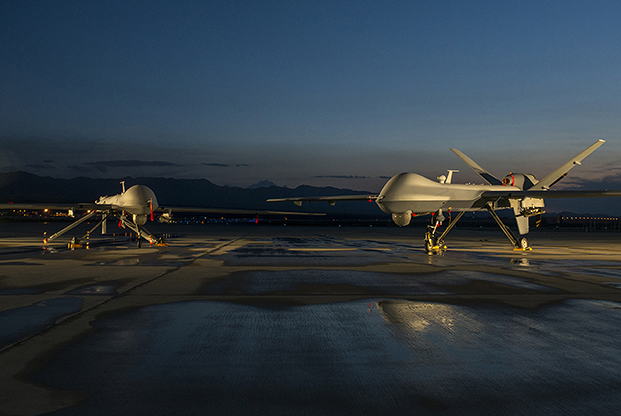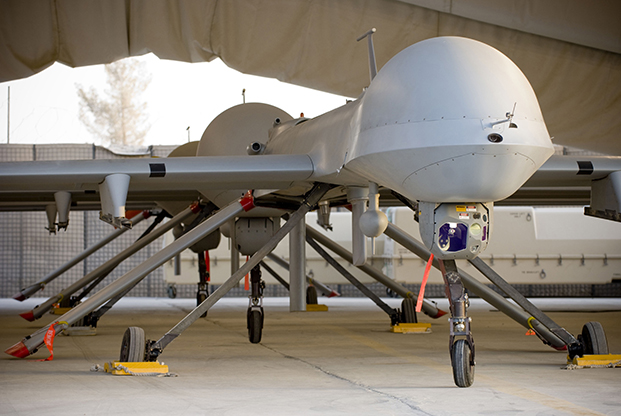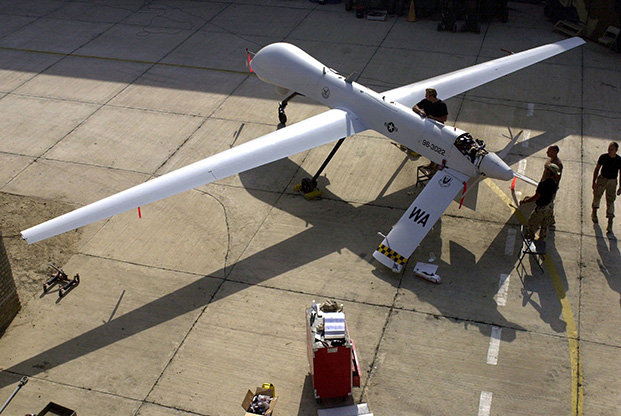
An MQ-1 Predator (left) and an MQ-9 Reaper stand ready at Creech AFB, Nev. Photo: SSgt. Vernon Young Jr.
The MQ-1 Predator, the remotely piloted aircraft that ushered in the era of drone warfare and permanently transformed modern combat, flew into the sunset during a March 9 retirement ceremony in the Nevada desert. Its mission has been taken over by the MQ-9 Reaper.
So indispensable was the MQ-1 to Air Force operations during its 24-year life span—during which the type amassed more than 2 million flight hours—that a Predator was flying a combat mission in the Middle East on the day of the retirement ceremony. It was a fitting swan song for an aircraft that spent more than 92 percent of its service life in combat.
“The MQ-1 has helped shape the character of warfare,” said Col. Julian C. Cheater, the commander of the 432nd Wing at Creech AFB, Nev., home to the RPA for 23 years.
James G. “Snake” Clark, a former Air Force colonel known as the “godfather” of the aircraft, described the spindly aircraft as “a glider with an Austrian-built (Rotax 214) snowmobile racing engine that races into combat slower than the SUVs on the Beltway in Washington, D.C.”
The Predator traces its lineage back to a $40 million contract from the Defense Advanced Research Projects Agency to Leading Systems Inc. for the “Amber” medium unmanned aerial vehicle.
_Read this story in our digital issue:
Abraham Karem, an engineer born in Baghdad, Iraq, and raised in Israel, spent years developing early UAVs in his California garage before designing Amber, which came in at a cost of $350,000 per aircraft. These early variants faced reliability challenges stemming from frequent operator error and no “standard procedures” for flight, Karem told Air Force Magazine last year.
Amber’s successor, the GNAT-750 long-endurance tactical UAV, flew in 1989. Variants of this aircraft flew surveillance over air bases, supply caches, and troop movements in Albania, Bosnia, and Croatia.
In 1990, General Atomics Aeronautical Systems Inc. bought Leading Systems and continued developing UAVs. In January 1994, the company received an Advanced Concept Technology Demonstration contract for a medium-altitude endurance UAV based on the GNAT-750. It evolved into what would become known as the RQ-1.
Used experimentally in a Roving Sands exercise in 1995, the RPA was a success, and a US Army composite unit deployed the aircraft in Albania as part of Joint Task Force Provide Promise between July and November 1995.
Pentagon leaders quickly saw the aircraft’s value, and about a year later a prototype Predator deployed to Europe to fly as part of NATO Operations Deny Flight and Deliberate Force in Bosnia-Herzegovina. At the time, the aircraft was an Army asset and was operated in theater by soldiers using a plywood runway.
In the early days of Predator operations, the Air Force pressed to take over the mission. Air Combat Command in July 1995 stood up the 11th Reconnaissance Squadron at Indian Springs Air Force Auxiliary Field, Nev., in anticipation of being assigned the RQ-1.
In April 1996, Defense Secretary William J. Perry made the shift official, and USAF transitioned the RQ-1 from a test platform to an operational system flown by US Atlantic Command.
USAF pilots flew the Predator remotely from Taszar, Hungary, for Operation Joint Endeavor—the implementation of the Dayton Peace Accords regarding the conflict in the Balkans. At the time, the Predator “cockpit” was a converted NASCAR auto trailer fitted with computers, controls, and monitors. The aircraft transmitted color television and infrared video surveillance.
Predator showed real potential as an intelligence, surveillance, and reconnaissance tool in its early years, but the program experienced growing pains. The aircraft flew low and slow and suffered a frightful accident rate of 43 lost per 100,000 hours, compared with two or three per 100,000 hours for manned aircraft. Inexperienced maintainers and a lack of spare parts contributed to the mishaps.
The drone flew so slowly that in Bosnia, a Serbian helicopter reportedly flew alongside a Predator and shot at it with door-mounted machine guns.
For the first five years of Predator operations, it was purely a watcher system, providing what commanders at the time called “staring” ISR. It wasn’t until 1999 that Air Force leaders began to think about using the RQ-1 to provide targeting data.
In April of that year, then-USAF Chief of Staff Gen. Michael E. Ryan called Snake Clark to inquire about this possibility and tasked him to observe Predator operations in Kosovo. They were flying 24-hour-a-day operations in search of hostile forces.
Clark reached out to the USAF’s Big Safari office at Wright-Patterson AFB, Ohio, which modifies aircraft for special missions, such as the RC-135 Rivet Joint and EC-130H Compass Call.
After evaluating Predator, Big Safari suggested the aircraft’s sensor ball be replaced with a new unit, used by the Navy, that could not only observe with a camera but designate a target with a laser.
Just 18 hours after USAF approved Big Safari’s recommendation, the service was buying the new sensor ball, and just 38 days later an upgraded Predator was flying missions over Kosovo.
By 2000, Air Combat Command wanted not only to fit the whole fleet with laser target designators but to give the aircraft armament as well. ACC wanted Predator to be both sensor and shooter.
Because of the aircraft’s small size and relatively weak wings, Big Safari determined it could only carry the Army’s Hellfire missile—a small anti-tank weapon carried by helicopters. During a 2001 test, a Predator successfully fired a Hellfire at the Nellis Test Range in Nevada, destroying a tank. This feat occurred just 61 days after ACC’s order to arm the Predator, at a cost of $2.9 million.
Now that it could shoot, within a year, the RQ-1 became the MQ-1 (“M” standing for “multimission” under USAF nomenclature rules).

GNAT-750 was the first long-endurance remotely piloted aircraft. It would evolve into the RQ-1 Predator. Courtesy photo
A NEW ERA OF WARFARE
Testing the armed Predator was still underway at Edwards AFB, Calif., on Sept. 11, 2001, when terrorists struck the US. Just over two hours after the attacks on New York and Washington, D.C., USAF received presidential approval to deploy the newly lethal Predator. Two days later, a C-17 landed at then-Andrews AFB, Md., with three Predators, 13 Hellfire missiles, ground control stations, … and a rented Jeep that had to be returned to Hertz at Reagan National Airport in Washington, Clark said.
One of the three MQ-1s that then deployed to Afghanistan was tail number 3034—the first to fire a Hellfire in testing. This same Predator was also the first to fire a Hellfire in combat over Afghanistan, and it is now on display at the Smithsonian’s National Air and Space Museum in Washington.
The Predator was integral during the early years of operations in Afghanistan and Iraq, becoming more effective with the addition of upgraded video capabilities, remote split operations, and improved weapons.
In 2005, 11 years after the beginning of the ACTD program, the MQ-1 officially reached initial operating capability.
Predator production ended in 2011, with delivery of the 268th aircraft. At the same time, demand for persistent ISR was skyrocketing. In 2004, the Air Force flew just five combat air patrols, which translated to 20 Predators flying 24-hour orbits over targets of interest. By 2016, though, USAF was flying 60 CAPs, while the Army was flying its own RPAs, and still more government-owned drones were being flown by contractors. It still wasn’t enough to meet commanders’ voracious demand.
The Predator’s operations in Afghanistan and Iraq ushered in the era of “drone warfare,” with a persistent eye watching potential targets and even providing close air support for US and allied ground forces. Predators flew ISR and strike missions as part of ongoing missions in Yemen, Somalia, and Libya.
Since 2008, MQ-1s flew almost 70,000 sorties—executing almost 2,700 strikes.

Three Predators in a hangar at a base in southern Afghanistan. MQ-1s were integral to operations in the early years of operations in Afghanistan and Iraq. Photo: SSgt. Samuel Morse
MQ-1s did not just serve in combat. Predators were requested to provide reconnaissance of the storm-ravaged city after Hurricane Katrina hit New Orleans in 2005, but the Federal Aviation Administration had no rules for allowing RPAs to operate in domestic airspace over inhabited land. Predator camera systems wound up being mounted on skyscrapers in the Katrina relief effort.
However by 2006, Air National Guard-operated Predators were given the green light for use in disaster responses of various kinds. They flew ISR during wildfires and after hurricanes domestically and assisted international aid efforts after earthquakes hit Port-au-Prince, Haiti, in 2010.
In 2014, Predators were the first to respond to what would become a four-year-long effort, so far, against ISIS. As the fighters with that group rapidly took over parts of Iraq, Predators were dispatched to the area and told to “go north,” Cheater said.
There were no rules of engagement at the time; no detailed guidance. Predators were the eyes for the US and its coalition partners as ISIS surrounded Mount Sinjar in Iraq and began trying to wipe out the Yazidi people. The response from the international community was Operation Inherent Resolve.
Since then, MQ-1s flew in every major battle against ISIS, including the liberation of Mosul, Iraq, and Raqqa, Syria. MQ-1 operations prevented ISIS from destroying dams and helped save the Yazidis.
Predators saw 17 years of constant combat in the Middle East as a mainstay of operations. From its first operational missions through early 2018, the Predator flew a total of 135,750 sorties and 2,061,864 flight hours. Of that total, 1,904,287 flight hours were in combat—92.4 percent of its flying total.
As MQ-1 operations expanded, Predator’s footprint at Creech swelled considerably. Previously known as Indian Springs, an auxiliary airfield for Nellis used mainly for marshaling Red Flag forces, the surrounding area had little more than “a casino and a gas station,” Clark recounted. The surrounding area was so vacant that few would notice—much less care—if a Predator crashed. Creech has since become the global hub of RPA operations.
The original cadre of just one squadron—the 11th Reconnaissance Squadron (redesignated the 11th Attack Squadron in 2016)—grew into a wing at Creech that also governed Active Duty, Guard, and Reserve MQ-1 squadrons across the country.
The unit—which Clark described as “pirates and misfits” for cobbling a capability out of small amounts of money and appropriating space, resources, and missions along the way—“wrote Air Force history,” Clark said.
“Those who have designed this aircraft, who have flown this aircraft, who have maintained this aircraft, who have supported it in some way have epitomized this ability to take an idea and rapidly transform it into a vital resource,” Cheater said.

Members of the 11th Reconnaissance Squadron preflight a Predator at an undisclosed location during Operation Enduring Freedom. Photo: TSgt. Scott Reed
FUTURE OF THE ‘AWAY GAME’
The MQ-1 was an integral part of every combat operation since 1995, but USAF is already well into the MQ-9 Reaper era.
The Reaper fleet is expected to surpass the Predator fleet’s peak, with a total of 346 aircraft to be flown at several bases across the service. To find the pilots to fly them, the Air Force has opened its pilot ranks to enlisted airmen, letting them train to fly the RQ-4 Global Hawk—which does not release ordnance—so more officers can take the controls of MQ-9s.
In 2015, USAF requested a large funding increase to build up its MQ-9 fleet, as well as its ranks of pilots and maintainers, to keep it healthy as the service’s ISR commitments expand.
Despite the retirement ceremony, as of April USAF still had 128 MQ-1s in its fleet. Many of these have been placed in crates, with some still awaiting “demilitarization” before they are sent to a final destination, according to ACC. The Air Force doesn’t anticipate the US will sell these aircraft to allied nations, and some have already been chosen for display in museums in the US and England.

A1C Chris Korenaga checks the camera system of an RQ-1 Predator at Balad AB, Iraq. The unmanned aerial vehicle performed surveillance and reconnaissance patrols around the base’s perimeter. Photo: SSgt. Cohen Young
The Predator’s ability to have constant eyes and ready weapons over a battlefield a world away from its pilot means the US is able to have an “away game” against the “world’s most ruthless enemies,” without putting airmen in peril, Cheater said.
“Wars are destructive,” Karem noted. For the United States, the goal is “to win with the minimum casualties … both us and them. And I think armed UAVs being able to … look at the targets for a long time and throw a small missile, can do that better than an F-16 coming with a 2,000-pound bomb.”
Although hardly an air show crowd pleaser, with its spindly profile and low-power engine (and indeed, it never flew in air shows, as all available aircraft were dedicated to operations throughout its service life), Predator was a highly significant warplane in the changes it brought to modern warfare, Karem said.“While the Predator may fly slowly, our enemies are afraid of it for good reason,” Cheater observed. “We have been able to reach long distances, to fly sorties for longer than 22 hours, to launch a precision Hellfire missile through a specific window to remove callous snipers, and as a result, our joint and coalition forces sing the praises of the mighty MQ-1.”